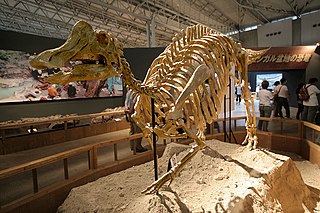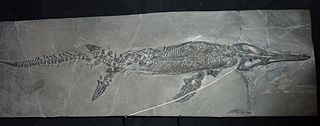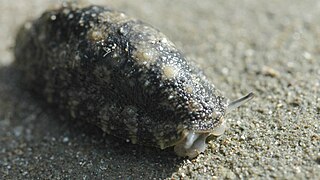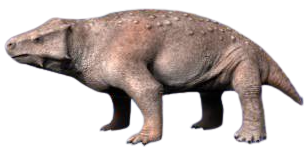Related Research Articles

Cuckoos are birds in the Cuculidae family, the sole taxon in the order Cuculiformes. The cuckoo family includes the common or European cuckoo, roadrunners, koels, malkohas, couas, coucals, and anis. The coucals and anis are sometimes separated as distinct families, the Centropodidae and Crotophagidae, respectively. The cuckoo order Cuculiformes is one of three that make up the Otidimorphae, the other two being the turacos and the bustards. The family Cuculidae contains 150 species, which are divided into 33 genera.

The Rhizophoraceae is a family of tropical or subtropical flowering plants. It includes around 147 species distributed in 15 genera. Under the family, there are three tribes, Rhizophoreae, Gynotrocheae, and Macarisieae. Even though Rhizophoraceae is known for its mangrove members, only the genera under Rhizophoreae grow in the mangrove habitats and the remaining members live in inland forests.

Achatinidae is a family of medium to large sized tropical land snails, terrestrial pulmonate gastropod mollusks from Africa.

Inostrancevia is an extinct genus of large carnivorous therapsids which lived during the Late Permian in what is now European Russia and South Africa. The first-known fossils of this gorgonopsian were discovered in the Northern Dvina, where two almost complete skeletons were exhumed. Subsequently, several other fossil materials were discovered in various oblasts, and these finds will lead to a confusion about the exact number of valid species in the country, before only three of them were officially recognized: I. alexandri, I. latifrons and I. uralensis. More recent research carried out in South Africa has discovered fairly well-preserved remains of the genus, being attributed to the species I. africana. The whole genus is named in honor of Alexander Inostrantsev, professor of Vladimir P. Amalitsky, the paleontologist who described the taxon.

Tupuxuara is a genus of large, crested, and toothless pterodactyloid pterosaur from the Early Cretaceous period of what is now the Romualdo Formation of the Santana Group, Brazil, about 125 to 112 million years ago. Tupuxuara is a close relative of Thalassodromeus, and both form a group that is either called Thalassodrominae or Thalassodromidae.

Nipponosaurus is a lambeosaurine hadrosaur from sediments of the Yezo Group, in Sinegorsk on the island of Sakhalin, which was part of Japan at the time of the species' classification. The type and only species is N. sachalinensis, known only from a single juvenile specimen discovered in 1934 and named in 1936, by Takumi Nagao, with further material of the same individual found in 1937. Since then, the taxon has been largely ignored, and its validity has been doubted, with synonymy with other Asian hadrosaurs or status as a nomen dubium being suggested. Redescriptions from 2004 and 2017, however, have supported recognition as a distinct species. Dating the only specimen has been difficult, but based on associated mollusc taxa, the species likely lived sometime in the upper Santonian or lower Campanian, around 80 million years ago.

Quinkana is an extinct genus of mekosuchine crocodylians that lived in Australia from about 28 million to about 10,000 years ago. Most attributed specimens have been found in Queensland. It is speculated to have been one of the top predators of Pleistocene Australia.

Mixosaurus is an extinct genus of Middle Triassic ichthyosaur. Its fossils have been found near the Italy–Switzerland border and in South China.

Haloragaceae is a eudicot flowering plant family in the order Saxifragales, based on the phylogenetic APG system. In the Cronquist system, it was included in the order Haloragales.

Dinilysia is an extinct genus of snake from the Late Cretaceous (Coniacian) of South America. Dinilysia was a relatively large ambush predator, measuring approximately 2 m (6.6 ft) long. The skull morphology of Dinilysia is similar to boids, suggesting that it was able to consume large prey. Living in a desert-like environment, Dinilysia is likely a terrestrial or a semi-fossorial animal.

Onchidiidae are a family of small, air-breathing sea slugs. They are shell-less marine pulmonate gastropod molluscs. Onchidiidae is the only family within the superfamily Onchidioidea.

Draparnaudia is a genus of air-breathing land snails, terrestrial pulmonate gastropod mollusks in the superfamily Partuloidea.

Subulininae is a subfamily of small tropical air-breathing land snails, terrestrial pulmonate gastropod mollusks in the family Achatinidae.

Tupandactylus is a genus of tapejarid pterodactyloid pterosaur from the Early Cretaceous Crato Formation of Brazil.

Phreatophasma is an extinct genus of synapsids from the Middle Permian of European Russia. It includes only one species, Phreatophasma aenigmatum, which is itself known from a single femur found in a mine near the town of Belebei in Bashkortostan. Phreatophasma comes from a fossil assemblage that is latest Ufimian to earliest Kazanian in age under the Russian stratigraphic scheme, correlating with the Roadian Age under the international stratigraphic timescale. Because the species is based on a single specimen with few diagnostic anatomical features, uncertainty remains as to where it belongs in tetrapod phylogeny; originally interpreted in 1954 as an enigmatic "theromorph" synapsid by Soviet paleontologist Ivan Yefremov, Phreatophasma was later described as a therapsid incertae sedis by American paleontologist Alfred Romer in 1956 and then as a member of a basal synapsid family called Caseidae starting with Everett C. Olson in 1962. Olson's classification was later supported by Canadian paleontologist Robert Reisz in 1986 and American paleontologist Robert L. Carroll in 1988. Ivakhneneko et al. (1997) and Maddin et al. (2008) both considered Phreatophasma an indeterminate synapsid.
Paropeas achatinaceum is a species of air-breathing land snail, a terrestrial pulmonate gastropod mollusc in the family Achatinidae.

Artemonopsis is a genus of air-breathing land snails, terrestrial pulmonate gastropod mollusks in the family Streptaxidae.
Glaurung is an extinct genus of weigeltisaurid reptile from the Upper Permian of Germany. The only known species is Glaurung schneideri. Originally considered a specimen of Coelurosauravus, a later study named it as a new genus after noting that it had several unique characteristics relative to other weigeltisaurids. These characteristics included a low skull, small eyes, smooth parietal and squamosal bones, and spiny jugal bones.

Parasaurus is a genus of pareiasaur known from fossils collected in the Kupferschiefer in Germany, dating to the Late Permian (Wuchiapingian). The type species, Parasaurus geinitzi, described by Hermann von Meyer in 1857, was the first pareiasaur ever described. The seven known specimens were redescribed in 2008.
References
- ↑ Bank, R. (2017). Classification of the Recent terrestrial Gastropoda of the World. Last update: July 16, 2017. . World Register of Marine Species , Retrieved 10 January 2019.
- ↑ Naggs F. (1994). "The reproductive anatomy of Paropeas achatinaceum and a new concept of Paropeas (Pulmonata: Achatinoidea: Subulinidae)". Journal of Molluscan Studies60(2): 175-191. doi : 10.1093/mollus/60.2.175.